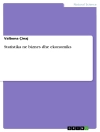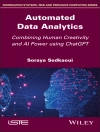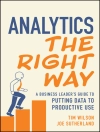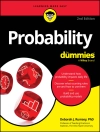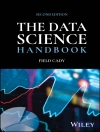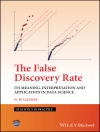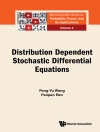Praise for the Fourth Edition
‘The book follows faithfully the style of the original edition. The approach is heavily motivated by real-world time series, and by developing a complete approach to model building, estimation, forecasting and control.’
— Mathematical Reviews
Bridging classical models and modern topics, the Fifth Edition of Time Series Analysis: Forecasting and Control maintains a balanced presentation of the tools for modeling and analyzing time series. Also describing the latest developments that have occurred in the field over the past decade through applications from areas such as business, finance, and engineering, the Fifth Edition continues to serve as one of the most influential and prominent works on the subject.
Time Series Analysis: Forecasting and Control, Fifth Edition provides a clearly written exploration of the key methods for building, classifying, testing, and analyzing stochastic models for time series and describes their use in five important areas of application: forecasting; determining the transfer function of a system; modeling the effects of intervention events; developing multivariate dynamic models; and designing simple control schemes. Along with these classical uses, the new edition covers modern topics with new features that include:
- A redesigned chapter on multivariate time series analysis with an expanded treatment of Vector Autoregressive, or VAR models, along with a discussion of the analytical tools needed for modeling vector time series
- An expanded chapter on special topics covering unit root testing, time-varying volatility models such as ARCH and GARCH, nonlinear time series models, and long memory models
- Numerous examples drawn from finance, economics, engineering, and other related fields
- The use of the publicly available R software for graphical illustrations and numerical calculations along with scripts that demonstrate the use of R for model building and forecasting
- Updates to literature references throughout and new end-of-chapter exercises
- Streamlined chapter introductions and revisions that update and enhance the exposition
Time Series Analysis: Forecasting and Control, Fifth Edition is a valuable real-world reference for researchers and practitioners in time series analysis, econometrics, finance, and related fields. The book is also an excellent textbook for beginning graduate-level courses in advanced statistics, mathematics, economics, finance, engineering, and physics.
สารบัญ
Preface to the Fifth Edition xix
Preface to the Fourth Edition xxiii
Preface to the Third Edition xxv
1 Introduction 1
1.1 Five Important Practical Problems 2
1.2 Stochastic and Deterministic Dynamic Mathematical Models 6
1.3 Basic Ideas in Model Building 14
Appendix A. 1 Use of the R Software 17
Exercises 18
Part One Stochastic Models and Their Forecasting 19
2 Autocorrelation Function and Spectrum of Stationary Processes 21
2.1 Autocorrelation Properties of Stationary Models 21
2.2 Spectral Properties of Stationary Models 34
Appendix A2. 1 Link Between the Sample Spectrum and Autocovariance Function Estimate 43
Exercises 44
3 Linear Stationary Models 47
3.1 General Linear Process 47
3.2 Autoregressive Processes 54
3.3 Moving Average Processes 68
3.4 Mixed Autoregressive–Moving Average Processes 75
Appendix A3. 1 Autocovariances Autocovariance Generating Function, and Stationarity Conditions for a General Linear Process 82
Appendix A3. 2 Recursive Method for Calculating Estimates of Autoregressive Parameters 84
Exercises 86
4 Linear Nonstationary Models 88
4.1 Autoregressive Integrated Moving Average Processes 88
4.2 Three Explicit Forms for the ARIMA Model 97
4.3 Integrated Moving Average Processes 106
Appendix A4. 1 Linear Difference Equations 116
Appendix A4. 2 IMA(0, 1, 1) Process with Deterministic Drift 121
Appendix A4. 3 ARIMA Processes with Added Noise 122
Exercises 126
5 Forecasting 129
5.1 Minimum Mean Square Error Forecasts and Their Properties 129
5.2 Calculating Forecasts and Probability Limits 135
5.3 Forecast Function and Forecast Weights 139
5.4 Examples of Forecast Functions and Their Updating 144
5.5 Use of State-Space Model Formulation for Exact Forecasting 155
5.6 Summary 162
Appendix A5. 1 Correlation Between Forecast Errors 164
Appendix A5. 2 Forecast Weights for any Lead Time 166
Appendix A5. 3 Forecasting in Terms of the General Integrated Form 168
Exercises 174
Part Two STOCHASTIC MODEL BUILDING 177
6 Model Identification 179
6.1 Objectives of Identification 179
6.2 Identification Techniques 180
6.3 Initial Estimates for the Parameters 194
6.4 Model Multiplicity 202
Appendix A6. 1 Expected Behavior of the Estimated Autocorrelation Function for a Nonstationary Process 206
Exercises 207
7 Parameter Estimation 209
7.1 Study of the Likelihood and Sum-of-Squares Functions 209
7.2 Nonlinear Estimation 226
7.3 Some Estimation Results for Specific Models 236
7.4 Likelihood Function Based on the State-Space Model 242
7.5 Estimation Using Bayes’ Theorem 245
Appendix A7. 1 Review of Normal Distribution Theory 251
Appendix A7. 2 Review of Linear Least-Squares Theory 256
Appendix A7. 3 Exact Likelihood Function for Moving Average and Mixed Processes 259
Appendix A7. 4 Exact Likelihood Function for an Autoregressive Process 266
Appendix A7. 5 Asymptotic Distribution of Estimators for Autoregressive Models 274
Appendix A7. 6 Examples of the Effect of Parameter Estimation Errors on Variances of Forecast Errors and Probability Limits for Forecasts 277
Appendix A. 7 Special Note on Estimation of Moving Average Parameters 280
Exercises 280
8 Model Diagnostic Checking 284
8.1 Checking the Stochastic Model 284
8.2 Diagnostic Checks Applied to Residuals 287
8.3 Use of Residuals to Modify the Model 301
Exercises 303
9 Analysis of Seasonal Time Series 305
9.1 Parsimonious Models for Seasonal Time Series 305
9.2 Representation of the Airline Data by a Multiplicative (0, 1, 1) × (0, 1, 1) 12 Model 310
9.3 Some Aspects of More General Seasonal ARIMA Models 325
9.4 Structural Component Models and Deterministic Seasonal Components 331
9.5 Regression Models with Time Series Error Terms 339
Appendix A9. 1 Autocovariances for Some Seasonal Models 345
Exercises 349
10 Additional Topics and Extensions 352
10.1 Tests for Unit Roots in ARIMA Models 353
10.2 Conditional Heteroscedastic Models 361
10.3 Nonlinear Time Series Models 377
10.4 Long Memory Time Series Processes 385
Exercises 392
Part Three Transfer Function and Multivariate Model Building 395
11 Transfer Function Models 397
11.1 Linear Transfer Function Models 397
11.2 Discrete Dynamic Models Represented by Difference Equations 404
11.3 Relation Between Discrete and Continuous Models 414
Appendix A11. 1 Continuous Models with Pulsed Inputs 420
Appendix A11. 2 Nonlinear Transfer Functions and Linearization 424
Exercises 426
12 Identification, Fitting, and Checking of Transfer Function Models 428
12.1 Cross-Correlation Function 429
12.2 Identification of Transfer Function Models 435
12.3 Fitting and Checking Transfer Function Models 446
12.4 Some Examples of Fitting and Checking Transfer Function Models 453
12.5 Forecasting with Transfer Function Models Using Leading Indicators 461
12.6 Some Aspects of the Design of Experiments to Estimate Transfer Functions 469
Appendix A12.1 Use of Cross-Spectral Analysis for Transfer Function Model Identification 471
Appendix A12.2 Choice of Input to Provide Optimal Parameter Estimates 473
Exercises 477
13 Intervention Analysis, Outlier Detection, and Missing Values 481
13.1 Intervention Analysis Methods 481
13.2 Outlier Analysis for Time Series 488
13.3 Estimation for ARMA Models with Missing Values 495
Exercises 502
14 Multivariate Time Series Analysis 505
14.1 Stationary Multivariate Time Series 506
14.2 Vector Autoregressive Models 509
14.3 Vector Moving Average Models 524
14.4 Vector Autoregressive–Moving Average Models 527
14.5 Forecasting for Vector Autoregressive–Moving Average Processes 534
14.6 State-Space Form of the VARMA Model 536
14.7 Further Discussion of VARMA Model Specification 539
14.8 Nonstationarity and Cointegration 546
Appendix A14. 1 Spectral Characteristics and Linear Filtering Relations for Stationary Multivariate Processes 552
Exercises 554
Part Four Design of Discrete Control Schemes 559
15 Aspects of Process Control 561
15.1 Process Monitoring and Process Adjustment 562
15.2 Process Adjustment Using Feedback Control 566
15.3 Excessive Adjustment Sometimes Required by MMSE Control 580
15.4 Minimum Cost Control with Fixed Costs of Adjustment and Monitoring 582
15.5 Feedforward Control 588
15.6 Monitoring Values of Parameters of Forecasting and Feedback Adjustment Schemes, 599
Appendix A5. 1 Feedback Control Schemes Where the Adjustment Variance Is Restricted, 600
Appendix A15. 2 Choice of the Sampling Interval 609
Exercises 613
Part Five Charts and Tables 617
Collection of Tables and Charts 619
Collection of Time Series Used for Examples in the Text and in Exercises 625
References 642
Index 659
เกี่ยวกับผู้แต่ง
The late George E. P. Box, Ph D, was professor emeritus of statistics at the University of Wisconsin-Madison. He was a Fellow of the American Academy of Arts and Sciences and a recipient of the Samuel S. Wilks Memorial Medal of the American Statistical Association, the Shewhart Medal of the American Society for Quality, and the Guy Medal in Gold of the Royal Statistical Society. Dr. Box was also author of seven Wiley books.
The late Gwilym M. Jenkins, Ph D, was professor of systems engineering at Lancaster University in the United Kingdom, where he was also founder and managing director of the International Systems Corporation of Lancaster. A Fellow of the Institute of Mathematical Statistics and the Institute of Statisticians, Dr. Jenkins had a prestigious career in both academia and consulting work that included positions at Imperial College London, Stanford University, Princeton University, and the University of Wisconsin-Madison. He was widely known for his work on time series analysis, most notably his groundbreaking work with Dr. Box on the Box-Jenkins models.
The late Gregory C. Reinsel, Ph D, was professor and former chair of the department of Statistics at the University of Wisconsin-Madison. Dr. Reinsel’s expertise was focused on time series analysis and its applications in areas as diverse as economics, ecology, engineering, and meteorology. He authored over seventy refereed articles and three books, and was a Fellow of both the American Statistical Association and the Institute of Mathematical Statistics.
Greta M. Ljung, Ph D, is a statistical consultant residing in Lexington, MA. She received her doctorate from the University of Wisconsin-Madison where she did her research in time series analysis under the direction of Professor George Box. Dr. Ljung’s career includes teaching positions at Boston University and Massachusetts Institute of Technology, and a position as Principal Scientist at AIR Worldwide in Boston. Her many accomplishments include joint work with George Box on a time series goodness of fit test, which is widely applied in econometrics and other fields.


